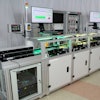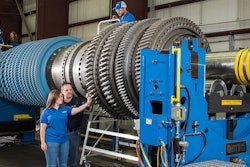
 Bill Bernhardt, Senior Commercial Engineer, Rockwell Automation
Bill Bernhardt, Senior Commercial Engineer, Rockwell AutomationThe task is to purchase a soft starter for your motor.
You want a nice easy start versus an across-the-line start from an electro-mechanical starter. You have a motor with a nameplate that states 100 HP, FLA of 124 amps, NEMA Design B, and KVA Code G.
Being around motors before, one would think nothing out of the ordinary here. Should you stop there and select a soft starter based on that? Not necessarily...
What is not pointed out on the nameplate is the percent starting torque and general look of the speed torque curve. Why is that important? It is important because this helps determine whether or not the selected soft starter is viable.
Over the past few years, mandates to motor efficiency have caused motor characteristics to change. While the above data used to be good for sizing starters in the past, it is not necessarily enough moving forward and should be thought about when replacing an older motor.
Case in point, a recent look at a data sheet for fictitiously named “XYZ” motor stated that the motor was 500 HP, 8 pole, NEMA B, Code G. OK, looks good, nothing abnormal. Until you look at the locked rotor torque. This was at 90 percent. Is this a good candidate for a soft starter?
Maybe, but then again, maybe not.
Let me explain. The motor torque needs to be higher than the load torque demanded throughout the starting process for the motor to start. If the motor starting torque is less than the load demanded torque, a stall situation or overload trip will most likely happen, preventing further thermal damage to the motor. The end result is an unsuccessful start.
By design, a soft starter utilizes voltage to control torque. The available motor torque is approximately proportional to the square of the applied voltage.
%Torque α %Voltage2
Given this relationship, a 60 percent reduction in the applied voltage results in approximately an 84 percent reduction in generated torque. In this example, 40 percent voltage is used.
(0.4)2 = 0.16, or 15% of Locked Rotor Torque is present
So now you look at a speed torque curve having a locked rotor torque compared to full running torque at 90 percent. Reduce your voltage to 40 percent as in the example, and now you have 16 percent of the actual starting torque. That is pretty low. This value may or may not be enough to start the motor.
This was an example based on math. Of course, the reduced voltage can be adjusted to provide a start up to 100 percent. The point is, if there is little margin of torque to play with because the starting torque level percent is so low to start with, the use of a soft starter is diminished.
The most common motor used is the NEMA Design B. Many traditional NEMA Design B motors are/were 150 - 250 percent or higher for percent locked rotor torque compared to full running torque.
It is now common to see motors with much lower initial percent starting torque. This needs to be taken into account when looking at a soft starter for an application.
 This drawing shows the common comparisons between the different NEMA designs A, B, C and D speed torque curves.
This drawing shows the common comparisons between the different NEMA designs A, B, C and D speed torque curves.Bill Bernhardt Senior Commercial Engineer, Rockwell AutomationThis was an example based on math. Of course, the reduced voltage can be adjusted to provide a start up to 100 percent. The point is, if there is little margin of torque to play with because the starting torque level percent is so low to start with, the use of a soft starter is diminished.
The most common motor used is the NEMA Design B. Many traditional NEMA Design B motors are/were 150 - 250 percent or higher for percent locked rotor torque compared to full running torque.
It is now common to see motors with much lower initial percent starting torque. This needs to be taken into account when looking at a soft starter for an application.
The best chances of versatility when using a soft starter is to have a motor that has a speed torque curve well above the full load torque value. When the percent locked rotor torque is close to or below full load torque, closer scrutiny should be applied.
In the recent past, many speed torque curves have become lower and flatter characteristically from the locked rotor torque to the breakdown torque of the curves.
Motors have changed. While these motors may work for a given application, a little homework maybe needed to verify whether the motor will work in reduced voltage mode. A soft starter does not create energy, it controls it.
Bill Bernhardt is the Senior Commercial Engineer at Rockwell Automation. This article originally appeared on Rockwell Automation's website here.






















